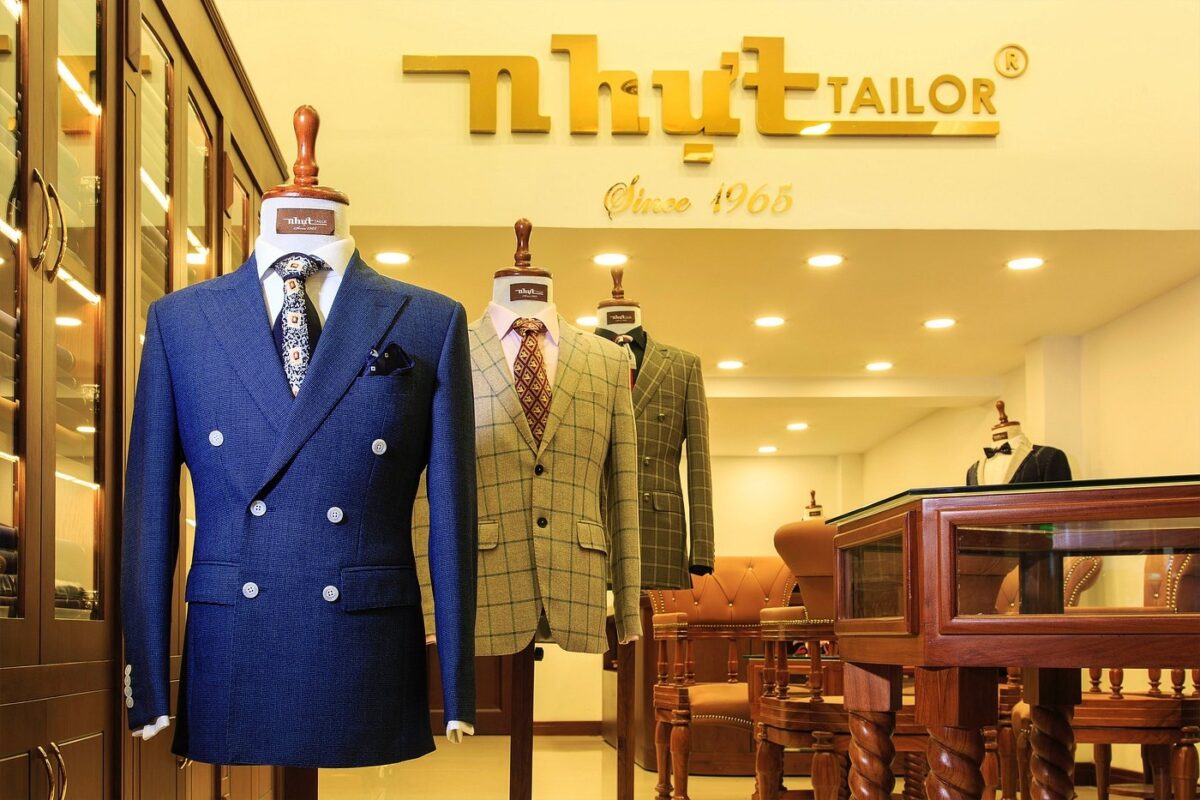If in Vietnam, each city or province has its own distinctive dishes, then with Vietnamese drinks, you can find them anywhere. Not only famous for its rich cuisine, the various beverages are also an indispensable part of Vietnamese life. To list all the drinks on the menu, you might feel overwhelmed, wondering when you’ll ever be able to try all the Vietnamese drinks.
Perhaps you’ve heard of drinks like bubble tea, iced coffee, or smoothies, but have you ever tried more unusual yet familiar drinks like coconut water, sugarcane juice, or calamansi tea? These drinks are closely linked to cultural development and are widely available in Vietnam. In this article, let’s listen to the stories behind each drink and explore the refreshing flavors they bring. Just step into the world of beverages in Vietnam, and you may want to stay in Vietnam a little longer!
Some Notes For You to Enjoy Vietnamese Drinks
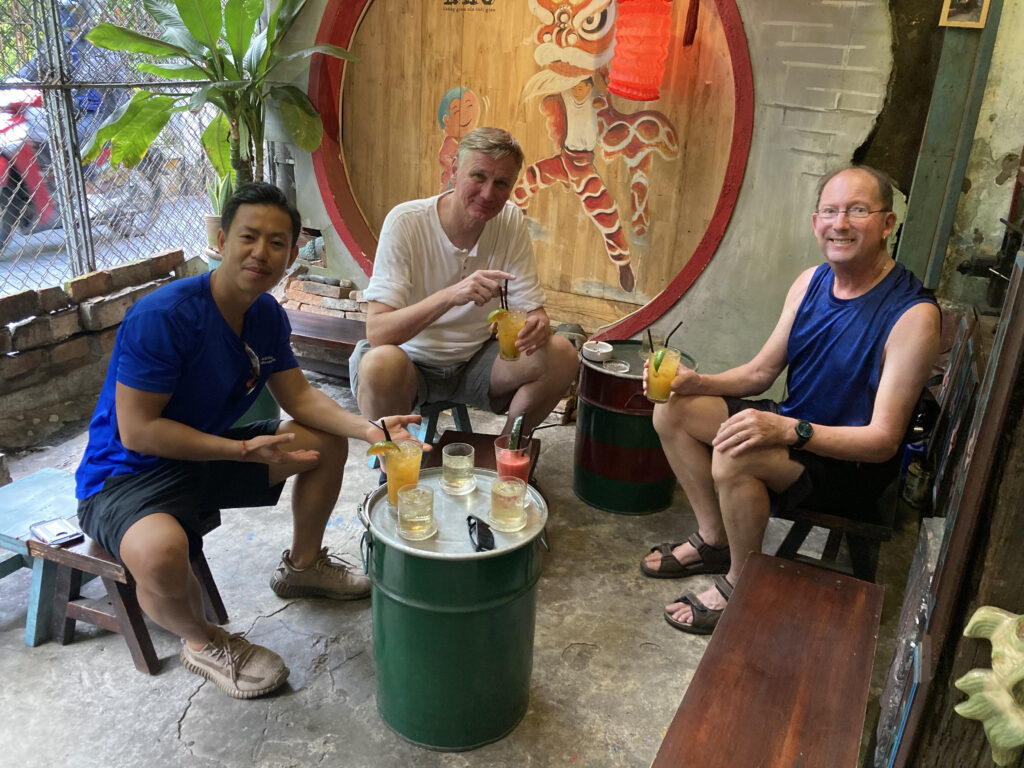
Before diving into the exploration and enjoyment of Vietnamese drinks, here are a few tips to enhance your experience:
- For caffeinated drinks like coffee or tea, it’s better to drink them in the morning rather than in the afternoon to avoid sleepless nights.
- Many drinks in Vietnam can be very sweet due to the high amount of sugar added. If you’re not a fan of sweetness, you can ask the seller to reduce the sugar percentage when placing your order. You can also inquire about using natural sweeteners like honey or palm sugar if you’re avoiding refined sugar.
- Additionally, if you have health issues like diabetes or allergies to certain ingredients in beverages, don’t hesitate to discuss this with the seller to choose the most suitable drink for you.
- You can also enjoy Vietnamese drinks with food to create a perfect combination, like drinking various teas while eating pastries or bread to balance the flavors and harmonize the palate.
Now, let’s get started understanding this list to immerse signature Vietnamese drinks!
Let’s Explore Top 11 Must Try Refreshing Vietnamese Drinks
Nước Dừa – Fresh Coconut Water
Refreshing Vietnamese Drinks
Coconut water is one of the most popular and beloved refreshing drinks in Vietnam. It can be said that coconut water is a national beverage because you can find it for sale in both upscale restaurants and along the roadside. Especially on hot summer days, coconut water shines even brighter in people’s eyes.

Even in rural areas, locals cultivate coconut trees so that they can enjoy coconut water and coconut meat during the season to cool off. A coconut tree can grow up to 25 meters tall and usually bears 5 to 10 coconuts. Besides picking the fruit to drink, people also utilize coconut leaves to make brooms, baskets, mats, or even to thatch roofs for shade from the rain and sun.
A healthy coconut typically ripens in about 11 to 12 months, but generally, coconuts are harvested between 5 to 7 months because, at this time, the coconut water is the most fragrant and nutritious. Another reason is that as coconuts ripen, they contain less water and have more coconut meat (the white part surrounding the coconut water); if overly ripe, this coconut meat becomes hard and loses a certain sweetness. In addition to the refreshing taste of coconut water, coconut meat is also something you should try.

Like other Vietnamese drinks, coconut water is widely sold on the streets. In many shops, you can buy bottled coconut water that is pre-chilled, or the vendor may start chopping a coconut and serve it whole without pouring it into a cup, allowing you to drink directly from the raw coconut. What’s even more special is that you can experience the sensation of chopping a coconut and then tasting the first drop of coconut water as a reward for your labor.

Moreover, coconut water is very beneficial for health; the ancients often said, “drinking young coconut water means avoiding the need for supplements” because it helps boost your immune system, maintain body shape, and rejuvenate your skin.
Nước Mía – Sugar Cane Juice
Refreshing Vietnamese Drinks
When summer comes, sugarcane juice is mentioned as a star among refreshing drinks because its thirst-quenching ability is unmatched by few Vietnamese drinks. Similar to coconut water, sugarcane juice also has many health benefits due to the sugar content in sugarcane that can prevent cancer and improve the digestive system thanks to the potassium content in sugarcane balancing the pH level in the stomach. Therefore, sugarcane juice is always what Vietnamese people think of when looking for a cheap yet nutritious drink.

Although dubbed the goddess of refreshing Vietnamese drinks, not everyone knows about the history of sugarcane, as it has quite a dark past. Looking back to the 13th century, Middle Eastern countries began to cultivate sugarcane extensively and decided to bring sugarcane to Europe to serve the royal families. Due to its rarity, sugarcane at that time was seen as a symbol of status and power. Consequently, products carved from sugarcane emerged and became decorative items on the dining tables of wealthy tycoons.

Recognizing the potential for development, an explorer brought sugarcane to colonial countries, forcing more than a million Africans into slavery to produce sugar. Due to overwork combined with many dangerous diseases and labor accidents, many children lost their lives in the workplace without receiving any compassion from the landowners of that time. Despite this, with relentless cultivation, by the 16th century, sugar officially became a crucial commodity, leading the world, and European empires successfully accumulated vast wealth solely from sugar exports.

By the 19th century, sugar had spread across many countries worldwide, including Vietnam. Sugarcane juice was extracted and often mixed with coconut milk, mung beans, or salted lime to enhance its unique flavor, causing many people to want a second glass after finishing the first. However, you shouldn’t drink sugarcane juice frequently if you have gastrointestinal issues or are trying to lose weight, as sugarcane contains a large amount of sugar, making up about 70%.

Sinh Tố – Fruit Smoothies
Refreshing Vietnamese Drinks
Smoothies are probably not too unfamiliar as they are a popular drink in many countries. In Vietnam, smoothies are considered a “miracle medicine” for detoxification in Vietnamese drinks because they are a type of beverage made by blending various vegetables, fruits, seeds, and yogurt – all of which are very good for the body’s cleansing process.
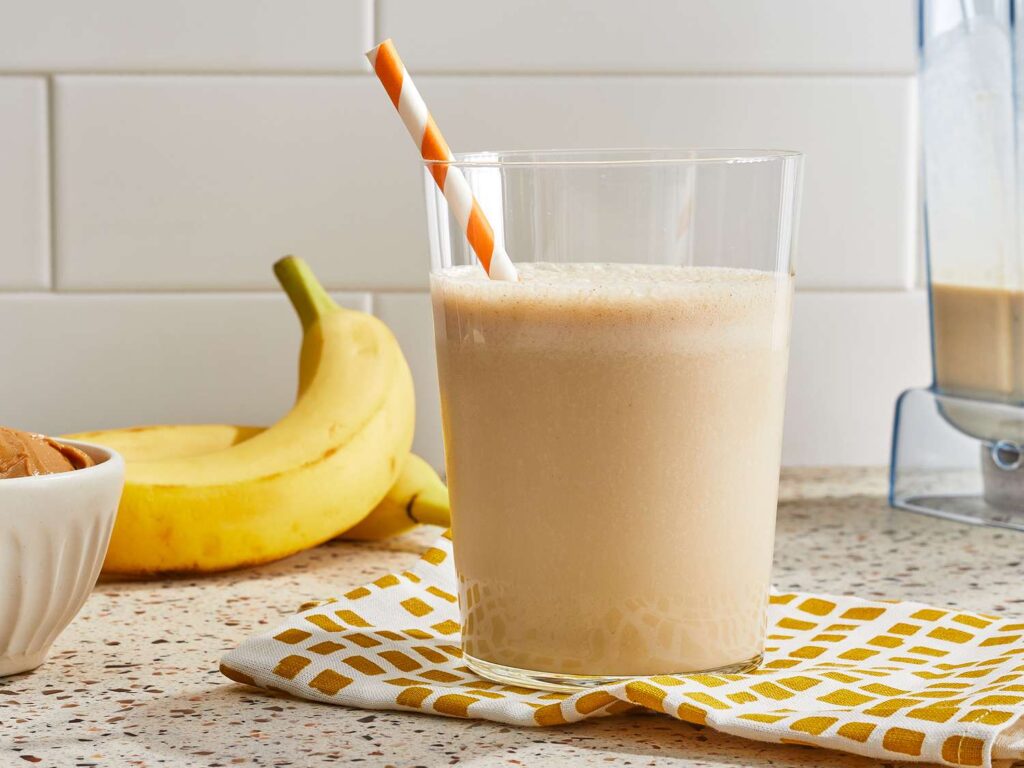
Smoothies are also one of the favored Vietnamese drinks in Vietnam, and the process of preparing a nutritious smoothie is quite simple. Vendors carefully select the fruits, then wash and chop them, before placing everything into a blender along with some crushed ice and sweetened condensed milk or fresh coconut water to enhance the creaminess. Or if you prefer to eat ice cream, try freezing the fruits in the freezer and then blending them; you will end up with a delicious fruit ice cream to enjoy on hot days.

In coffee shop in Vietnam, you will have many choices of different types of smoothies such as avocado smoothie, mango smoothie, soursop smoothie, strawberry smoothie, etc. Each type of smoothie has its own unique flavor. If you enjoy the sweet and creamy taste of avocado or the juicy flavor of mango, you can choose a mango avocado smoothie; any type of fruit can be mixed according to your personal preference.

Trà Sữa – Bubble Tea
Refreshing Vietnamese Drinks
Not only popular in many countries, bubble tea has also become a “hot trend” in Vietnam since its introduction, becoming a national drink for the youth at school gates, along sidewalks, and in Vietnamese drink shops. Among bubble tea enthusiasts, there’s a catchy phrase that people often share: “Whether the tea is poured into the milk or the milk is poured into the tea, it’s all the same. So why haven’t you fallen for me yet?” This is a playful line that young people use to flirt with their crushes. Additionally, bubble tea serves as a powerful “weapon” in romance, as boys often buy bubble tea for their girlfriends to show care and affection.

The most popular types of bubble tea in Vietnam are milk tea with tapioca pearls, available in various flavors like chocolate, matcha, or strong oolong tea. The appeal of bubble tea lies in the perfect blend of the rich flavors of tea and milk, combined with the chewy tapioca pearls. Besides tapioca, bubble tea can also be paired with many other toppings such as fruit jelly, khúc bạch, cocoa powder, or whipped cream, providing customers with a variety of options to suit their tastes.
In Ho Chi Minh City, you can enjoy bubble tea from brands like Koi Thé, Bababop, The Alley, Gong Cha, Toco Toco, Phúc Long Milk Tea, and The Coffee House. Alternatively, you can buy bubble tea from street vendors along various roads. These vendors often have unique flavors because their recipes are usually family secrets. As a result, despite being sold on the street, they attract large crowds. Bubble tea represents the richness of Vietnamese drinks.

Trà Tắc – Kumquat Tea
Refreshing Vietnamese Drinks
When walking down the street, you’re sure to encounter street vendors selling kumquat tea, lemon tea, and orange juice. These are all perfect Vietnamese drinks that you can easily purchase while out and about. The blend of tea, kumquat, and ice creates a refreshing flavor that provides instant relief, cooling your body.

Furthermore, kumquat tea is a rich source of vitamin C from kumquats (a relative of lemons), which helps boost your immune system, enhance skin beauty, and aid digestion. Additionally, the antioxidants in tea can help your body fight free radicals, contributing to heart health. Kumquat tea is easy to buy and simple to make at home; drinking it is not only a way to quench your thirst but also a natural health care method in Vietnam.
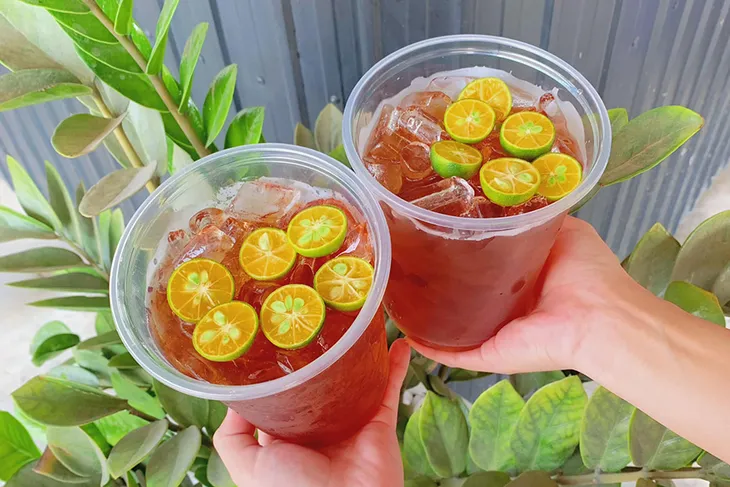
Trà Atiso – Artichoke Tea
Refreshing Vietnamese Drinks

Made from artichoke flowers, artichoke tea always has a vibrant color and a gentle aroma, providing a relaxing feeling from the very first sip. In Vietnam, popular types of artichoke tea you can try include red artichoke tea, green artichoke tea, fruit-infused artichoke tea, and honey artichoke tea. These teas have a light flavor that is good for digestion, detoxifying the liver, and can especially help reduce stress and tension after a long day at work.
However, artichoke tea is not suitable for individuals with stomach issues, pregnant women, those with low blood pressure, or anyone on certain medications. If you have any of these conditions, it is advisable to limit your intake of artichoke tea to ensure your health.
Nước Sâm – Herbal Tea
Refreshing Vietnamese Drinks

Herbal tea is made from earth ginseng (or ginseng) and various natural herbs such as rock sugar, licorice, or some fruits, providing a light aftertaste and a slight bitterness on the tongue. For a long time, ginseng has been used in traditional medicine as a precious remedy for many ailments. Consequently, ginseng tea has become widely available in Vietnam, as people believe it can enhance health, improve vitality, and prolong life.

In Vietnamese culture, ginseng tea often appears during festivals, parties, or gatherings with friends and family. The image of ginseng tea stalls by the roadside remains a popular spot where people gather to chat and enjoy a refreshing cup of ginseng tea, making it an essential part of Vietnamese cultural life. If you can, try cycling around the neighborhoods, weaving through winding alleys, and stopping to enjoy ginseng tea from street vendors; this will surely be an interesting experience worth trying at least once.
Cà Phê – Vietnamese Coffee
Refreshing Vietnamese Drinks

Coffee has long become an essential beverage around the world, and Vietnam is no exception. Coffee in Vietnam is grown and harvested in the highlands, where the climate and soil are ideal for coffee cultivation, such as in Đắk Lắk, Lâm Đồng, Gia Lai, and Kon Tum. With favorable conditions and the meticulous care of the locals, Vietnamese coffee has captured the hearts of international friends whenever they enjoy it.
Moreover, over the years, Vietnamese coffee has continuously received accolades at various competitions and has been praised in numerous prestigious international media outlets, including CNN’s article “Why the world is waking up to Vietnamese Coffee” and The New York Times’ piece “In Vietnam, Coffee Culture Brims With New Agency.”

On the menu of coffee shops, you can find standout varieties like Robusta coffee, Arabica coffee, Phin coffee, iced milk coffee, Bạc xỉu (coffee with a lot of milk), and coconut coffee. In addition to famous coffee chains like Highlands, The Coffee House, and Cà phê Cộng, you can experience the unique vibe of street-side coffee in the early morning, often paired with a hot baguette or a light package of sticky rice to start the day. This is a common activity among Vietnamese youth to enjoy a brief moment before heading to work or school.

In the realm of Vietnamese drinks, coffee is a beverage rich in caffeine, so here are some important notes to consider:
- Coffee can cause insomnia, so it’s best to drink it in the morning to feel alert and to limit consumption at least six hours before bedtime for a good night’s sleep.
- The average amount of coffee you can drink is between 1 to 3 cups a day to avoid excessive caffeine intake, which can lead to feelings of anxiety, nervousness, or insomnia.
- Avoid drinking coffee on an empty stomach, as it may irritate the stomach and lead to discomfort or stomach pain.
- Those with heart problems, high blood pressure, and pregnant women should also limit their coffee intake.
Read more this guide: A Beginner Guide to Enjoy Vietnamese Coffee in Ho Chi Minh City
Cà Phê Trứng – Egg Coffee
Refreshing Vietnamese Drinks
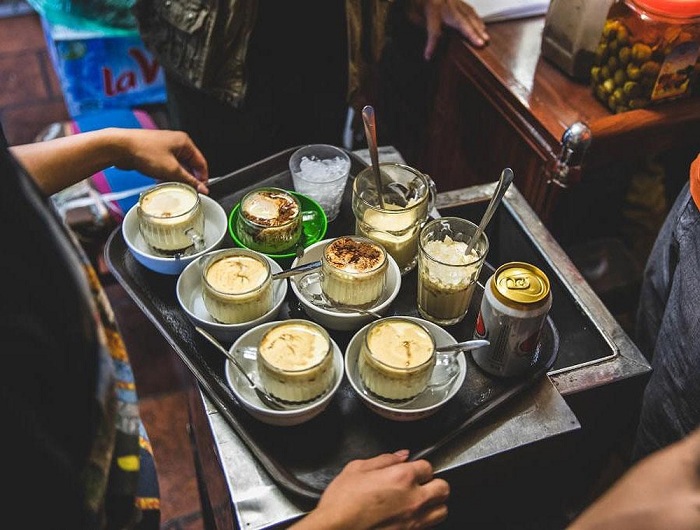
If you have a sweet tooth but don’t like to drink milk with your coffee, don’t worry—egg coffee is a perfect alternative for you. Egg coffee is not a new beverage in Vietnam; it was first created by a Vietnamese named Nguyễn Văn Giảng during the resistance against French colonialism in 1946. At that time, milk was a luxury item for the local population.
After his egg coffee gained popularity, Giảng opened his own café, and to this day, Giảng Coffee remains a well-known brand. He is regarded as the king of egg coffee in Vietnam, introducing this unique aspect of Vietnamese drinks to friends around the world.

The reason egg coffee is so beloved is because of the whipped egg yolk that combines with the mild bitterness of the coffee, offering a completely different experience from regular coffee. However, to create a delicious cup of egg coffee without the raw egg taste, the barista must master the technique of whipping the egg. If whipped too much, the coffee will lose its thick texture; if whipped too lightly, the coffee and egg yolk won’t blend well together. A well-made egg coffee will have a certain thickness, a strong egg aroma, and a hint of coffee fragrance.

You can enjoy egg coffee hot or cold, and it is available at popular cafés in major cities in Vietnam, such as:
Hanoi:
- Giảng Cafe: 39 Nguyen Huu Huan, Ly Thai To, Hoan Kiem, Ha Noi
- Đinh Cafe: 13 Dinh Tien Hoang, Hang Trong, Hoan Kiem, Ha Noi
- Cafe Phố cổ: 11 Hang Gai, Hang Trong, Hoan Kiem, Ha Noi
Ho Chi Minh City:
- Little Hanoi Egg Coffee: 119/5 Yersin, Pham Ngu Lao, District 1, Ho Chi Minh City
- Flat White Coffee: 274 Ly Tu Trong, Ben Thanh, District 1, Ho Chi Minh City
- Phin Xanh Vietnamese Coffee & Tea: 47 Phan Chu Trinh, Ben Thanh, District 1, Ho Chi Minh City
Bia – Vietnamese Beer
Refreshing Vietnamese Drinks
“Bia hơi” (draft beer) in Vietnam has always captivated the hearts of international friends visiting the country. For a long time, beer has become a familiar pastime for every generation, from the young to the old in Vietnam. Each evening, as the city lights up, people gather to sip on cold beers while sharing stories about all sorts of things. Beer acts as a catalyst, helping everyone relax and open up to friends and family. Day by day, the term “bia hơi” has become well-known, even rivaling “phở” or “bún chả” in terms of popularity among international friends, making Vietnamese beer a must-try when visiting Vietnam.

Popular beers in Vietnam include Hà Nội Beer, Sài Gòn Beer, 333 Beer, Tiger Beer, and Heineken. Although these brands have been around for a long time, during gatherings, people often debate which beer to drink, as each has a different taste. Generally, men prefer Hà Nội, Sài Gòn, and Heineken, while Tiger Beer tends to be favored by women for its milder flavor.

So, if you happen to stroll through the streets of Vietnam and are invited to join a local gathering, don’t hesitate to join in! Singing, enjoying refreshing beers, and listening to locals share fascinating stories about Vietnam will surely leave you with unforgettable impressions.

Rượu Gạo – Vietnamese Rice Wine
Refreshing Vietnamese Drinks
More than just a beverage, rice wine is an inseparable part of Vietnamese culture. The first batches of rice wine appeared in Vietnam in the Red River Delta, one of the largest rice-growing regions in Asia. After fermentation and several days of distillation, the rice wine is formed. During important occasions, locals will open the wine, use a ladle to pour it into cups and savor its flavor.

While rice wine can now be found everywhere, during the feudal period, especially under the Nguyễn dynasty, it was considered a luxury for the people because it was banned and only offered to kings and the royal family. After enduring a bloody struggle to preserve national identity, rice wine has survived through thousands of years of history.

Today, Vietnamese rice wine is a favorite among all social classes and has become an essential part of Vietnamese drinks, often enjoyed with traditional dishes. Many households brew their own rice wine, and numerous local shops sell it to meet the demands of the people.
As the saying goes, culture must be distinctive. Not only is rice wine enjoyed in the usual way, but there is also a unique way to savor it: through “rượu cần” (tube wine). Rượu cần is made by placing a long bamboo tube into a jar of rice wine, allowing people to sip the wine gradually. The wine is fermented directly with rice, combined with various herbs to create a distinctive flavor. This is truly one of the Vietnamese drinks you should try to experience the bitterness of the wine and the gentle sweetness of the rice.

Are You Ready to Try Vietnamese drinks?
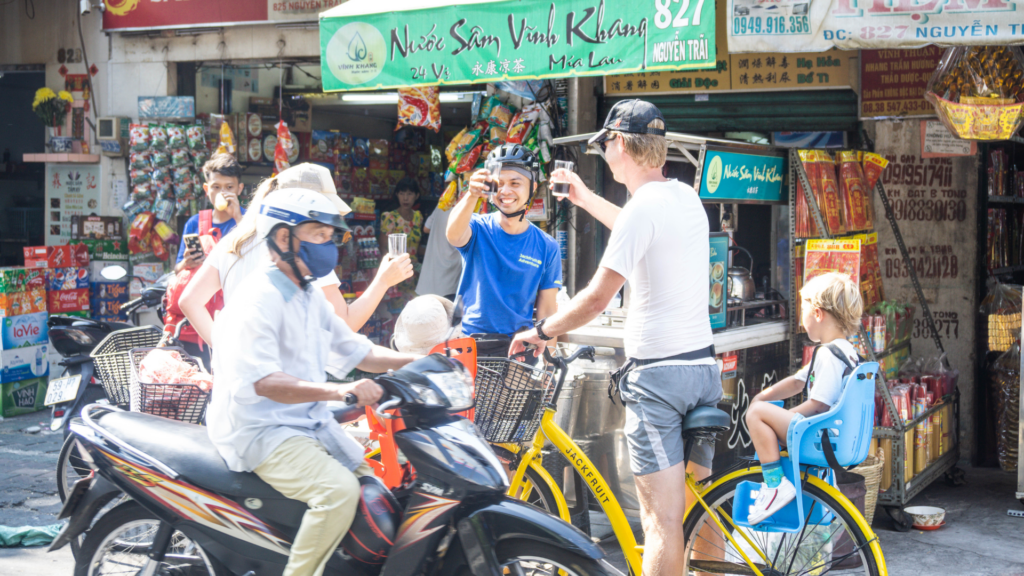
Vietnamese drinks are not just simple refreshments, they also offer numerous health benefits. From the refreshing coconut water, the aromatic coffee, to the soothing herbal tea, each drink is infused with the essence and heartfelt care of its creator. Like a thread that connects us, Vietnamese drinks bring people together during gatherings with friends and family.
Whether you enjoy these drinks at a small street-side stall or in a luxurious restaurant, the warm and friendly atmosphere will make you feel right at home, rather than in a foreign place. So, open your heart to the experience, savor, and embrace these unique flavors. Every sip is a memory, an emotion, and a part of the rich story of life and the people of Vietnam.
These articles will help you learn more about traveling in Ho Chi Minh City:
Let’s Join Our Cycling Tour in Ho Chi Minh City (Saigon) to Explore Vietnamese drinks!

When you arrive in Vietnam, you will be overwhelmed by the numerous tourist spots, restaurants, and places to enjoy Vietnamese drinks waiting to be explored. Especially if you are new to Vietnam for tourism, it can be even more challenging. You might feel anxious about time flying by without getting to any interesting places, tasting delicious dishes, or enjoying refreshing Vietnamese drinks. You may also worry about crossing the street due to the heavy traffic, or simply feel uncertain without a specific itinerary and the guidance of someone who knows the way.
If that’s your case, don’t worry! Exploration is a journey, and Jackfruit will accompany you on this adventure. Whether you are alone or with a large group of friends, just one bicycle will allow you to experience freedom while immersing yourself in the vibrant atmosphere of the city.

In addition to discovering historical sites rich in national spirit, you can ride around the streets and easily stop at charming roadside cafés, where you can savor fragrant iced coffee or refreshing sugarcane juice. Then, gently weave through narrow alleys to witness the daily lives of locals and engage with them. Moreover, you can uncover hidden gems of Saigon, peaceful spots that few people know about and where everyone who visits never wants to leave.

Not only will you be enchanted by breathtaking scenery, but you will also have the chance to pick lotus flowers, catch fish, cook, and then sit down for a meal with the locals to enjoy the fruits of your labor.
Rest assured, this entire journey will be guided and prepared by Jackfruit, providing you with bicycles, drinks, medical supplies, and other essentials. All you need to bring is an eager spirit to join us. It’s wonderful to explore the streets with your friends, cycling together while chatting, laughing, and tasting irresistible dishes. So don’t miss this opportunity and let’s grab your backpack and immerse yourself in the most memorable youthful journey of your life!




